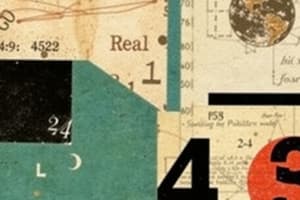Podcast
Questions and Answers
How do you find the sum of two rational numbers?
How do you find the sum of two rational numbers?
- Subtract the numbers
- Add the fractions or decimals (correct)
- Divide the numbers
- Multiply the numbers
What is the identity property for multiplication?
What is the identity property for multiplication?
- The result of multiplying any number by ten is ten times the original number
- The result of multiplying any number by zero is zero
- The result of multiplying any number by two is the double of the original number
- The result of multiplying any number by one is the original number (correct)
Which property states that for multiplication and addition, the order of the numbers being multiplied and added does not matter?
Which property states that for multiplication and addition, the order of the numbers being multiplied and added does not matter?
- Distributive property
- Associative property
- Identity property
- Commutative property (correct)
What happens if the denominator in a rational number division is zero?
What happens if the denominator in a rational number division is zero?
Which type of number cannot be expressed as a ratio of integers?
Which type of number cannot be expressed as a ratio of integers?
What are irrational numbers examples of?
What are irrational numbers examples of?
Which type of numbers can be expressed as a ratio between two integers?
Which type of numbers can be expressed as a ratio between two integers?
What property states that the sum of two rational numbers is always a rational number?
What property states that the sum of two rational numbers is always a rational number?
Which of the following is an example of a rational number?
Which of the following is an example of a rational number?
What is the subset of real numbers that includes all integers, fractions, and decimals with repeating patterns?
What is the subset of real numbers that includes all integers, fractions, and decimals with repeating patterns?
Which property ensures that the order of addition or multiplication does not matter for rational numbers?
Which property ensures that the order of addition or multiplication does not matter for rational numbers?
What distinguishes irrational numbers from rational numbers?
What distinguishes irrational numbers from rational numbers?
Flashcards are hidden until you start studying
Study Notes
Real Numbers: Rational Numbers
In mathematics, real numbers are the set of numbers that include all rational numbers and all irrational numbers. Rational numbers are numbers that can be expressed as a ratio between two integers, while irrational numbers cannot be expressed as a ratio of integers.
Rational Numbers
Rational numbers are a subset of real numbers. They are numbers that can be expressed as a ratio of two integers, where the denominator is not zero. This includes all integers (whole numbers, positive and negative), as well as fractions and decimal numbers that terminate or have a repeating pattern.
Examples of Rational Numbers
- 3/2 (as a fraction) or 1.5 (as a decimal)
- -5 (as an integer) or -5/1 (as a fraction)
- 2.2222... (a decimal that repeats forever) or 2.2 (as a fraction)
- 0.5 (as a decimal or as the fraction 1/2)
Properties of Rational Numbers
- Closure under addition: The sum of two rational numbers is always a rational number.
- Closure under subtraction: The difference between two rational numbers is always a rational number.
- Closure under multiplication: The product of two rational numbers is always a rational number.
- Closure under division: The quotient of two rational numbers is always a rational number (except for division by zero).
- Associative properties: The order of addition and multiplication does not matter.
- Commutative properties: The order of the numbers being added or multiplied does not matter.
- Identity properties: For addition, any rational number added to zero results in the original number. For multiplication, any number multiplied by one results in the original number.
- Distributive property: For multiplication and addition, the order of the numbers being multiplied and added does not matter.
Finding Rational Numbers
- Addition: To find the sum of two rational numbers, just add the corresponding fractions or decimals.
- Subtraction: To find the difference between two rational numbers, subtract the smaller from the larger (or vice versa).
- Multiplication: To find the product of two rational numbers, multiply the numerators and denominators separately, then simplify if possible.
- Division: To find the quotient of two rational numbers, divide the numerator by the denominator. If the denominator is zero, the quotient is undefined.
Real Numbers vs. Rational Numbers vs. Irrational Numbers
Real numbers include both rational and irrational numbers. Rational numbers are in the form of p/q, where p and q are integers, and q is not equal to zero. Irrational numbers, on the other hand, cannot be expressed as a ratio of integers. Examples of irrational numbers include √2, π, and e.
Studying That Suits You
Use AI to generate personalized quizzes and flashcards to suit your learning preferences.




